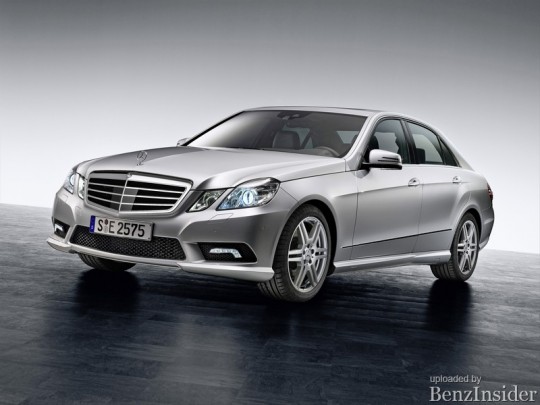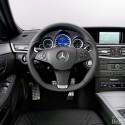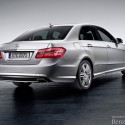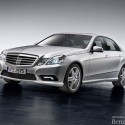Official: Mercedes-Benz introduces the new E-Class
Muamer Hodzic January 12, 2009
The curtain has finally been officially lifted off the next-generation E-Class from Mercedes-Benz. After years of spy shots/video illustrations and rumors, the day has finally come where we put all the behind us, as all the details have been published.
With the new E-Class, Mercedes-Benz is presenting the pacemaker when it comes to safety, comfort and environmental compatibility in this market segment. With more than 20 new or further technical developments, this saloon further consolidates the leading position of Mercedes-Benz in the luxury class. They include trailblazing innovations for safe driving that are available from no other manufacturer worldwide in this combination. Examples include the standard Attention Assist, Adaptive Main Beam Assist and automatic emergency braking, which is activated when there is acute danger of a collision.
Check out the entire gallery
Mercedes-Benz has improved the already exemplary long-distance comfort of the E-Class even further in the new saloon, including intelligent bodyshell technology with up to 30 percent greater rigidity, further improved seats and a newly developed suspension whose shock absorbers automatically adjust to the current driving situation. The optional air suspension now works together with an electronic damping system.
The outstanding safety and comfort of the E-Class are matched by its environmental compatibility and economy: the four- and six-cylinder engines are direct-injection units, and consume up to 23 percent less fuel than before. The combined NEDC consumption of the new four-cylinder diesel engines is just 5.3 litres per 100 kilometres, which corresponds to 139 grams of CO2 per kilometre. All the engines for the new E-Cass meet the EU5 emission standard, and in the case of the E 350 BlueTEC the emissions are already below the EU6 limits planned for 2014 .
Apart from the engines, the BlueEFFICIENCY package for the E-Class is in large part responsible for a considerable fuel saving. Engineers from every development department have worked together to optimise assemblies and components, to save fuel by means of reduced weight, a new form, improved functioning or efficient energy management.
The work done in the wind tunnel was particularly successful, for with a drag coefficient of only 0.25, the new E-Class is the world’s most aerodynamically efficient luxury saloon. It betters the already good Cd figure of the preceding model by another four percent, which represents a fuel saving of around 0.25 litres per 100 kilometres when driving at a motorway speed of 130 km/h. The aerodynamics are for example improved by variable fan louvres, which control the airflow to the engine compartment in line with requirements.
Other BlueEFFICIENCY measures include newly developed tyres with up to 17 percent lower rolling resistance, energy-saving control of the generator, fuel pump, air conditioning compressor and power steering, and the ECO start/stop functionwhich switches the engine of the new E 200 CGIoff when idling. Displays in the speedometer inform the driver how much fuel is being consumed (per 100 kilometres), and when he should shift to the next higher gear in the interests of an economical and environmentally conscious style of driving.
The range of engines available for the new E-Class comprises four, six and eight-cylinder units with outputs from 100 kW/136 hp to 386 kW/525 hp. The four-cylinder engines are newly developed direct-injection units, which develop a higher output and torque than the comparable V6-engines of the preceding series despite a smaller displacement. The strategy is to replace to replace large, naturally aspirated engines with turbocharged units which excel with advantages such as lower weight, reduced internal friction and more economical operating characteristics.
Engines: new CDI-four-cylinder units with a fuel consumption of just 5.3 litres and 139 grams of CO2 per kilometre
With three completely newly developed four-cylinder engines, the E-Class also remains one generation ahead where diesel technology is concerned. These engines feature latest-generation common-rail direct injection, fast piezo-electric injectors, improved exhaust gas recirculation and an innovative twin turbocharger, making for fast responsiveness and good performance characteristics. To express this in figures, the E 250 CDI with 150 kW/204 hp and 500 newton metres develops a 25 percent higher torque than the previous V6 diesel engine, but uses around 23 percent less fuel at only 5.3 litres per 100 kilometres (combined NEDC consumption). This corresponds to 139 grams of CO2per kilometre.
The new four-cylinder diesel engine also powers the E 220 CDI with 125 kW/ 170 hp and the E 200 CDI with 100 kW/136 hp, also with a fuel consumption of only 5.3 litres per 100 kilometres.
The top model in the new E-Class diesel range is the six-cylinder E 350 CDI with an output of 170 kW/231 hp, which uses 0.5 litres per 100 kilometres less fuel than the previous E 320 CDI. From autumn 2009 the V6 diesel will also be available as a BlueTEC model with the world’s best emission control technology. The E 350 BlueTEC develops 155 kW/211 hp and meets the EU6 exhaust emission standards planned for 2014. All the other engine variants in the new E-Class meet the EU5 limits.
Petrol engines: 20 percent fuel saving thanks to direct injection
The E 200 CGIand E 250 CGIare equipped with the newly developed four-cylinder direct-injection engine with a displacement of 1.8 litres, turbocharging and variable intake and exhaust camshafts. The E 200 CGI(135 kW/184 hp) is equipped with a six-speed manual transmission and the ECOstart/stop function as standard, and consumes only 6.8 litres of premium petrol per 100 kilometres (combined NEDC consumption, provisional figure). This equates to 159 grams of CO2per kilometre.
In the E 250 CGI(150 kW/204 hp), which has a five-speed automatic transmission as standard, maximum torque is now 310 newton metres, which represents an increase of more than 26 percent over the previous V6-engine. At the same time the NEDC fuel consumption is reduced by over 20 percent to 7.4 litres per 100 kilometres, equating to 175 grams of CO2per kilometre (provisional figures).
As before, the E 350 CGI with direct petrol injection (215 kW/292 hp) and the top-of-the-line E 500 (285 kW/388 hp) are included in the range of engine variants in the new E-Class. Detailed improvements have reduced the fuel consumption of these V6/V8 models by up to 0.6 litres per 100 kilometres. As a product from Mercedes-AMG, the new high-performance E 63 AMG develops 386 kW/525 hp.
The V6 and V8-models are equipped with a seven-speed automatic transmission and steering wheel selector lever as standard.
On request the V6 models E 350 CDIand E 350, as well as the eight-cylinder E 500, are available with latest-generation Mercedes all-wheel drive. This system distinguishes itself from previous all-wheel drive technology with greater efficiency, lower weight and more compact construction. These advantages produce noticeably better traction and fuel savings.
Safety: “Intelligent” partner thanks to unique combination of assistance and protection systems
For more than 50 years, the saloons in the E-Class and their predecessors have been acknowledged as trendsetters in the safety field. The new saloon continues this tradition with an unrivalled combination of the very latest assistance and protection system whose concept and development are based on what actually happens during accidents. These technologies make the E-Class an “intelligent partner”who can see, feel, react reflexively in critical situations and if necessary act independently to prevent accidents or mitigate their consequences. With this concept the new Mercedes model not only protects its own occupants, but also contributes decisively to the greater safety of other road users.
The new E-Class is the first automobile in the world whose headlamps adapt to the traffic situation and respond automatically to avoid dazzling other drivers. The optional Adaptive Main Beam Assist uses a camera on the windscreen to recognise oncoming traffic and vehicles moving ahead, and controls the headlamps so that their beams do not reach the other vehicle. This achieves the best possible road illumination in a given situation. The range of the dipped headlamp beams can be extended from 65 to up to 300 metres. If the road ahead is clear, the system performs a gentle transition to high beam.
Mercedes-Benz offers this new system as a light & sight package that includes bi-xenon headlamps, the Intelligent Light System and LED daytime driving lights.
The Lane Safety package for the new E-Class includes Blind Spot Assist familiar from the S-Class, and as a new development, Lane Keeping Assist which seeks to prevent the vehicle from leaving the road unintentionally. When the system recognises that the car is drifting from its lane, the driver is prompted to take countersteering action by brief but unmistakable vibrations of the steering wheel. The images from the windscreen camera are also used by the new, optionally available Speed Limit Assist , which recognises speed limit signs as the car passes them, then displays the relevant speed limit in the speedometer.
Night View Assist from the S-Class is now also available as an optional extra for the new E-Class. Mercedes-Benz has improved this system with a special pedestrian detection function: as soon as Night View Assist Plus recognises pedestrians ahead of the car, they are highlighted in the onboard display to provide a greatly enhanced warning effect.
Detection of drowsiness based on 70 parameters as standard
Thanks to an innovative technology, the new E-Class has developed a highly sensitive means of monitoring its driver’s attention level, and warns him of drowsiness in good time. This new ATTENTION ASSIST drowsiness detection system, which is standard equipment, is equipped with highly sensitive sensors that continuously monitor more than 70 different parameters. Observing the driver’s steering behaviour has proved to be a particularly strong indicator: several years of practical research by Mercedes engineers have shown that drowsy drivers make minor steering errors that can often be rapidly corrected in characteristic ways. These corrections are recognised by a highly sensitive steering angle sensor.
Automatic emergency braking when a collision is imminent
The well-proven, radar based assistance systems from the S-Class are now also optionally available to E-Class customers. A further development of the long-range radar sensor now has a range of 200 metres (previously 150 metres), and is able to monitor the mid-distance so that dynamic events such as a vehicle ahead suddenly pulling out to overtake can be detected even more effectively. The two wide-angle short-range radar sensors, which have a range of around 30 metres, continue to be included in the system.
The radar-supported systems are able to assist the driver with emergency braking. Their sensors are linked to the Brake Assist PLUS system, which automatically calculates the braking pressure to prevent a collision in critical situations. The driver is given an acoustic and visual warning at the same time. When the brake pedal is depressed, the system immediately activates the calculated level of braking assistance.
If the driver fails to respond to the warnings, the radar system first initiates partial braking action. As a second stage, if there is still no driver response and a collision is unavoidable, emergency braking is initiated. This can considerably lessen the severity of an accident, i.e. the system acts as something like an “electronic crumple zone”.
Active bonnet, seven airbags and PRE-SAFE® as standard
During the course of its development, the new E-Class was subjected to more than 150 high-speed crash tests and a total of more than 17,000 realistic crash simulations. The crumple zone principle invented by the Mercedes safety pioneer B©la Bar©nyi has been continuously improved by the engineers in Sindelfingen. The front-end deformation zone of the E-Class acts on four independent levels, and is even more effective than before. The increased use of highest-strength steel alloys also helps to ensure that the bodyshell is able to withstand high impact forces. Around 72 percent of all the body panels are made from these high-tech steels – yet another unrivalled figure in passenger car development.
With seven airbags as standard, belt tensioners, belt force limiters, crash-responsive head restraints and ISOFIX child seat attachments, the new E-Class has even more extensive safety features than the preceding model. Another new feature is the active bonnet, which is a continuation of many years of commitment to pedestrian protection on the part of Mercedes-Benz. It is standard equipment in the new E-Class. In the event of an impact, a system of springs raises the rear section of the bonnet by 50 millimetres within fractions of a second, thereby increasing the available deformation space. Thanks to the cleverly conceived mechanism, the driver is able to reset the active bonnet to its normal position himself, without visiting a workshop.
Another standard feature is the preventive occupant protection system PRE-SAFE®. In potentially hazardous situations this reflexively activates precautionary protective measures for the vehicle occupants, so that the seat belts and airbags are able to fulfil their protective function to the full during an impact.
Comfort: Further progresses with adaptive shock absorbers and improved air suspension
As in the safety field, the E-Class has been setting the standards for long-distance comfort in this vehicle class for several decades. Bettering the already high level of the preceding series, Mercedes engineers have achieved further advances with the new saloon – especially where ride, seating and climatic comfort are concerned.
Standard equipment includes a further improved suspension with adaptive shock absorbers. These automatically adapt to the current driving situation by reducing the damping forces when driving normally, thereby noticeably improving ride comfort. When taking bends at speed or during rapid evasive action, the system switches to the maximum damping effect so that the saloon is stabilised to best effect.
A version with dynamic damping characteristics and a lowered suspension is available as an optional alternative to the standard suspension (standard for the AVANTGARDE line).
The air suspension system optionally available for the V6 models (standard
in the E 500/E 500 4MATIC) has for the first time been combined with an electronically controlled damping system, which processes various sensor signals and controls each wheel independently. In this way Mercedes specialists have achieved significantly better ride comfort while improving handling safety and agility at the same time. The driver is able to select either comfort or sport mode at the touch of a button.
Well-proven seat technology with a new design
Where seat development is concerned, Mercedes-Benz had added a new quality to a well established Mercedes concept, namely padded seat piping – a sophisticated and demanding upholstery technique that is only used by Mercedes-Benz. This involves the insertion of an additional foam filling under the fabric or leather cover, and gives an immediate feeling of comfort and wellbeing when sitting in the car. There are different versions of this padded seat piping: in the basic model and AVANTGARDE line the upholstery is transversely contoured, while the ELEGANCE line has longitudinal piping and is reminiscent of the well-known and highly effective Mercedes seat design from the 1960s and 70s.
Active multicontour seats with massage function from the S-Class
The active multicontour seat package (optional) includes newly developed multicontour seats with comfort head restraints and a two-stage massage function in the backrest that has proven highly successful in the S-Class. Depending on the steering angle, lateral acceleration and vehicle speed, fast-acting piezo-electric valves on the air chambers in the backrests vary their pressure and volume to give the driver and front passenger even better lateral support.
On request the E-Class is also available with a rear seat unit consisting of two comfortable, single seats. This rear-seat comfort package includes seat heating, leather upholstery, a centre console, comfort head restraints, roller blinds in the rear doors, an electrically operated roller blind for the rear window, comfort sun visors and a through-loading facility to the boot.








Comments (4)
Pingback: Mercedes-Benz E-Class Coupe spy shots - part 4 | BenzInsider.com - A Mercedes-Benz Fan Blog
Pingback: Mercedes-Benz E-Class Coupe spy shots - part 4 | Mercedes Benz Ebay Auctions